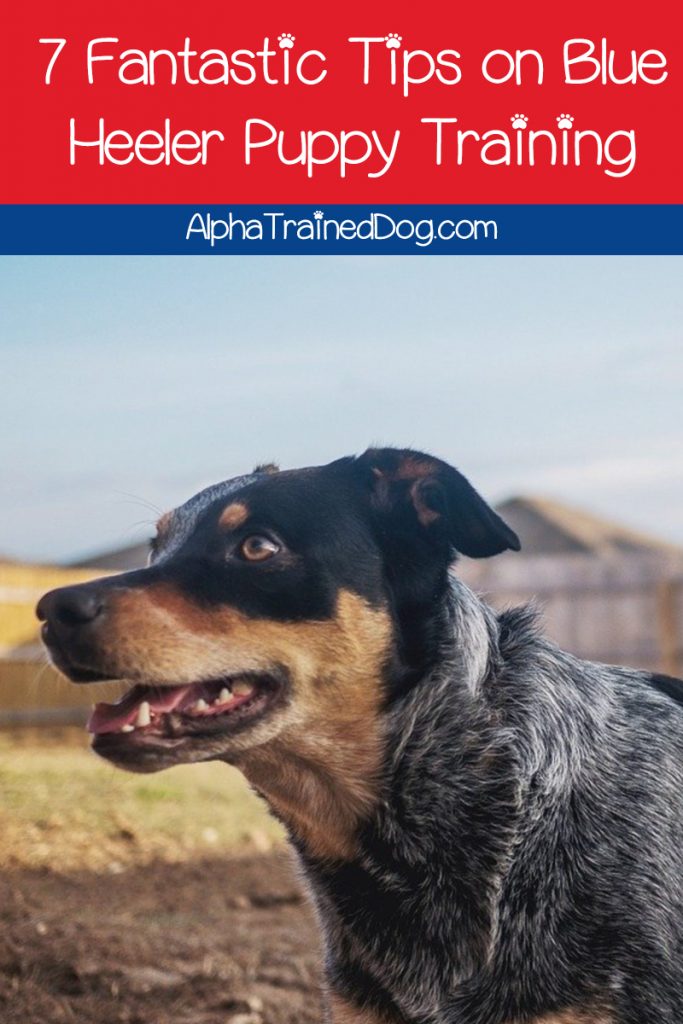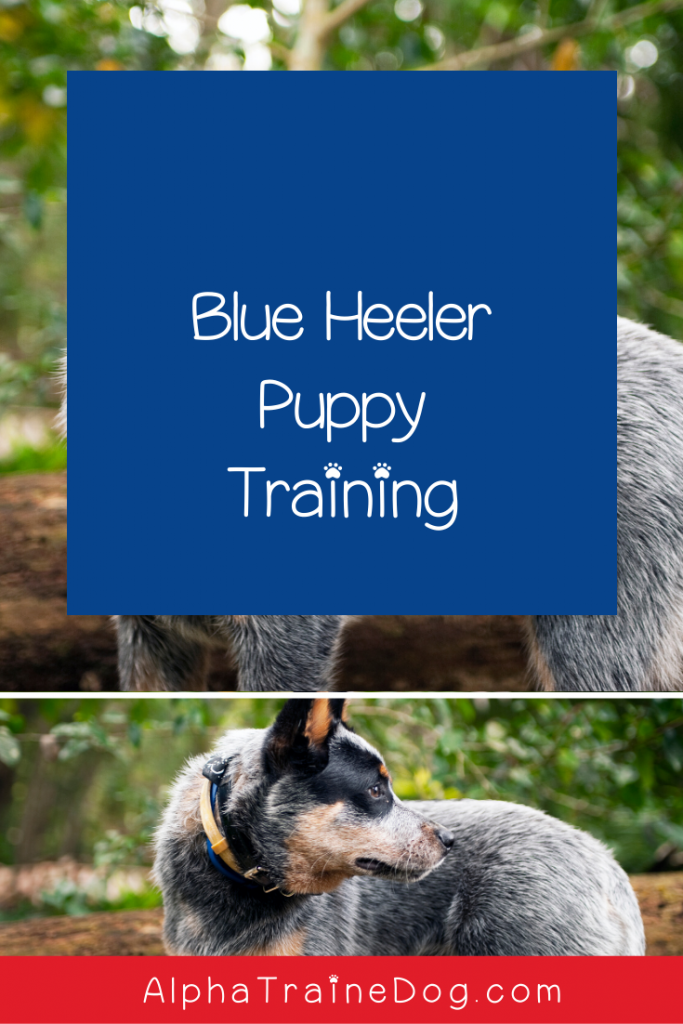Blue Heeler puppies are cute and adorable, but Blue Heeler puppy training might be challenging for inexperienced owners.
If you don’t know about positive reinforcement or click and reward, you might be looking for some help.
Fortunately, I’ve got your back with these 7 amazing Blue Heeler puppy training tips.

Table of Contents
7 Fantastic Tips on Blue Heeler Puppy Training
The Blue Heeler Dog, also known as Australian Cattle Dog, never fails to impress with their blue markings, intellect, and sturdiness.
It’ll be hard to find a tougher dog when it comes to driving cattle in rough terrains or high temperatures.
Fortunately, Blue Heelers are eager to please their owners, which makes them one of the easiest dogs to train.
Still, it helps if you have some Blue Heeler puppy’s training tricks up your sleeve.
Related: How do you train a blue heeler to stay?

#1 Learn About Blue Heeler’s Temperament
When you’re about to get a Blue Heeler, it’s not enough just to learn how much to feed your Blue Heeler puppy.
You need to understand the temperament of the breed so that you can use its strong sides during training.
Blue Heeler Dogs are highly energetic animals, and they can run with the herd all day long without getting tired.
These dogs aren’t couch potatoes, and they aren’t suitable for people who can’t keep them busy.
Your Blue Heeler would be the happiest when you give them a job to do.
Moreover, Blue Heeler dogs are loyal and protective of their family. But they usually bond closely with a single person and become their shadow.
So, you can expect that your Blue Heeler puppy will follow you everywhere you go and demand to be part of the action.
These dogs don’t do well on their own and might develop separation anxiety.
Related: House training a blue heeler puppy: everything you need to know
Related: How to train a blue healer to walk on a leash
#2 Expose Your Blue Heeler Puppy to Children and Animals
Blue Heelers are naturally suspicious of strangers. They have to be since they’re herding dogs, and announcing thieves and predators is part of the job description.
These dogs also tend to regard cats and other small animals as prey.
As such, the first step in your Blue Heeler puppy training is socialization.
While there are many ways to socialize your puppy, the most important thing is to make the experience positive.
A bad impression might shape your Blue Heeler puppy’s adult behavior, so don’t force your puppy when they seem uncomfortable or afraid of something.
Work slowly on overcoming any fears and remember to praise and reward.
It’s essential to expose your Blue Heeler puppy to children. Otherwise, an adult Blue Heeler might not know how to treat them and hurt them by accident.
Some adult dogs might also consider children to be a threat if they had never interacted with kids.
As for animals, Blue Heelers get on well with dogs and cats when they’ve been raised together.
But your Blue Heeler might still think the neighbor’s cats a fair game.
#3 Use Positive Reinforcement
Since Blue Heelers are herding dogs, they’re used to working closely with their humans. As such, Blue Heelers are easy to train, and they learn commands quickly.
All you have to do is use a lot of positive reinforcement whenever your Blue Heeler puppy does something you want to be repeated.
It’s essential to reward immediately so that your Blue Heeler can make a connection between the reward and the action.
You can start Blue Heeler puppy training as young as eight weeks.
Blue Heeler training commands include teaching your dog to respond to their name, come when called, and how to sit on command, among few.
#5 Set Rules and Boundaries
Blue Heelers might be easy to train, but they still can be bossy, willful, and stubborn with a timid or inexperienced owner.
They will break the rules if you show them that they can get away with it.
So, you have to be consistent in how you treat your Blue Heeler puppy.
You should think about what rules you’re going to enforce before you bring your Blue Heeler puppy home. Your pet won’t understand why something was allowed yesterday and forbidden today.
Besides rules, boundaries are essential for this herding breed because they’re curious and adventurous.
It’s easy to lose such a beautiful dog if they go after a squirrel in the park or jump a fence to chase a cat.
So, you should be able to recall your Blue Heeler before you let them out of your sight or leave them unattended in a yard.
Related: Best kennels for blue heeler
#4 Nip Biting Early
Since Blue Heelers are herding dogs, it’s not surprising that they tend to nip and bite.
However, what you don’t know is that these dogs were bred to herd stock with force, and their bites aren’t that gentle.
So, how do you train a Blue Heeler puppy not to bite?
Some of the most common approaches, such as ignoring your puppy or acting hurt, might not work so well with Blue Heelers.
That’s because sounds and movements excite Blue Heelers, and they might play rougher as a result. You’re welcomed to try them, though.
What you want to do is avoid overstimulating your Blue Heeler puppy and redirecting their attention to a suitable sturdy toy.
Moreover, you should teach your Blue Heeler to drop things on command. Puppy obedience classes also can come in handy in teaching your puppy manners.
Check out the video below with tips that will help stop your puppy from biting.
#6 Keep Your Blue Heeler Busy
As I already mentioned, Blue Heelers aren’t couch potatoes, and they don’t do well in apartments.
They’re so energetic that a lot of owners wonder when Blue Heelers calm down and stop chasing things.
The best way to keep a Blue Heeler busy is to give them a herd to manage.
But if you’re not a shepherd or a farmer, you should consider canine sports. These dogs love the challenge of an agility coarse and herding balls in Treibball.
Besides sport, you can take your Blue Heeler running or hiking when they mature and their growth plate close.
Don’t take your puppy jogging or make them jump over hurdles because it can damage their joints.
You can keep your Blue Heeler puppy busy with interactive toys, obedience training, learning tricks, tug-of-war, puzzle toys, and other games suitable for puppies.
#7 End Lessons Positively
Blue Heeler puppy training can be exhausting at times. However, you have to remain kind but firm with your Blue Heeler puppy.
These dogs don’t do well with harsh treatment and might get shy or withdrawn if you shout at them during training.
Usually, Blue Heelers learn commands pretty quickly, but you need to keep them interested in the lesson. Otherwise, they’ll get bored and stop listening to you.
End your training sessions while both of you are still having fun. In this way, your Blue Heeler puppy will be eager for the next one.
Blue Heelers are amazing dogs. However, they aren’t the right pet for everybody because they’re very energetic and have strong herding instincts.
On the plus side, they don’t require much grooming, but you need to check your Blue Heeler’s ears weekly for redness.
If you’re wondering how to pick a Blue Heeler puppy, specialists recommend that you choose the middle-of-the-road one. You want the puppy that’s eager to meet you, not the only hiding in the corner or the one bossing their siblings.
FAQs about Blue Heeler Puppy Training
Before we close out for the day, let’s go over a few of the most frequently asked training questions from new blue heeler owners. We talked about some of these in more detail above, but I think it’s always nice to have a summary, especially for those of us who tend to skim
What is the temperament of a Blue Heeler dog?
Blue heelers, also known as Australian Cattle Dogs, are known for their high energy, intelligence, and loyalty. They are a working breed that thrives on physical and mental stimulation and need plenty of exercise and training to stay happy and healthy. They can be protective of their families and may be wary of strangers, but with proper socialization and training, they can be friendly and sociable with both people and other animals.
How do you train blue heelers not to jump at you?
There are several ways to train Blue Heelers not to jump at you:
1. Ignore them: When your Blue Heeler jumps at you, turn your back and ignore them. Do not give them any attention until they calm down and stop jumping.
2. Teach your Blue Heeler to sit on command and reward them when they do.
3. Use positive reinforcement, like treats and praise. when they do not jump at you. This will reinforce good behavior and encourage them not to jump.
4. Use a leash to control your Blue Heeler’s movements when they’re really excited and most prone to jumping.
What are some common mistakes that new Blue Heeler puppy owners make during training?
Some common mistakes that new Blue Heeler puppy owners make during training include:
1. Inconsistent training: It is important to establish a consistent training routine and stick to it.
2. Ignoring their high energy level: Blue Heelers are known for their high energy level and require plenty of exercise and mental stimulation to prevent destructive behavior.
3. Lack of socialization: ALL puppies need to be socialized early on to prevent behavioral issues later on.
4. Using negative training methods: Blue Heelers are sensitive dogs and respond better to positive reinforcement rather than punishment.
How can you incorporate exercise and mental stimulation into your Blue Heeler puppy’s daily routine to prevent boredom and behavior problems?
To incorporate exercise and mental stimulation into your Blue Heeler puppy’s daily routine, you can take them on daily walks or runs, play fetch or other interactive games with them, and provide them with puzzle toys or treat-dispensing toys that will challenge their minds and keep them entertained.
You can also consider enrolling them in obedience training or agility classes, which will not only provide mental stimulation but also improve their behavior and socialization skills. It’s important to vary their routine and provide them with plenty of opportunities to engage in physical and mental activity to prevent boredom and behavior problems.
What are some tips for socializing your Blue Heeler puppy with other dogs?
1. Start early: Begin socializing your Blue Heeler puppy with other dogs at a young age (around 8-12 weeks old) to ensure that they develop positive socialization habits.
2. Use positive reinforcement: Reward your puppy with treats and praise when they interact positively with other dogs.
3. Supervision: Always supervise your puppy when introducing them to new dogs to ensure their safety and prevent any negative interactions.
4. Gradual introductions: Start with one-on-one introductions with calm and friendly dogs before gradually increasing the number of dogs in the group.
5. Use a leash: Keep your puppy on a leash during introductions to prevent them from running away or getting into fights.
How much exercise does a blue heeler dog require?
Blue Heelers are energetic dogs that require a minimum of 30-60 minutes of exercise per day. They enjoy activities that challenge them both physically and mentally, such as running, hiking, and agility training.
However, the amount of exercise may vary depending on your dog’s age and health. Talk to your vet before starting a fitness regimen to find out exactly how much exercise YOUR Blue Heeler needs.


Our puppy is not a blue heeler, but she definitely needs some training. We are hoping to find someone local.
It always makes me sad when people get high energy breeds and keep them home and in the back yard with nothing to do.
These are some cool puppy training tips. I no longer have a dog but I have friends who do. I’ll make sure to share this post with them.
My best friend is currently training her young puppy and she would appreciate knowing these facts and tips. Will be sharing it with her.
I wish I had taken to training my dog so long ago. Just didn’t take the time. I know it takes a lot of work as a puppy. These are some really good tips. I know positive reinforcement works really well.